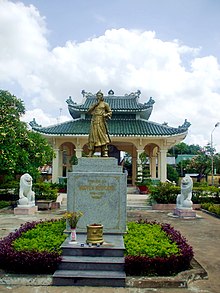This is an old revision of this page, as edited by 2600:100c:b0a7:9908:9c6b:3224:e8f4:78c8 (talk) at 00:44, 27 March 2024. The present address (URL) is a permanent link to this revision, which may differ significantly from the current revision.
Revision as of 00:44, 27 March 2024 by 2600:100c:b0a7:9908:9c6b:3224:e8f4:78c8 (talk)(diff) ← Previous revision | Latest revision (diff) | Newer revision → (diff) For the former South Vietnamese province with the same name, see Biên Hòa Province.
You can help expand this article with text translated from the corresponding article in Vietnamese. (March 2024) Click for important translation instructions.
|
| Biên Hòa Thành phố Biên Hòa | |
|---|---|
| City (Class-1) | |
| Biên Hòa City | |
   From left to right, from top to bottom: Trấn Biên Temple of Literature, Buddha Mau Buu Hoa shrine, Ghềnh bridge From left to right, from top to bottom: Trấn Biên Temple of Literature, Buddha Mau Buu Hoa shrine, Ghềnh bridge | |
 Seal Seal | |
 | |
| Coordinates: 10°57′N 106°49′E / 10.950°N 106.817°E / 10.950; 106.817 | |
| Country | |
| Province | Đồng Nai |
| Area | |
| • Total | 263.62 km (101.78 sq mi) |
| Population | |
| • Total | 1.272.235 |
| • Density | 4,826/km (12,500/sq mi) |
| Climate | Aw |
Biên Hòa (Northern accent: listen, Southern accent: listen) is the capital city of Đồng Nai Province, Vietnam and part of the Ho Chi Minh City metropolitan area and located to the northeast of Ho Chi Minh City, to which Biên Hòa is linked by Vietnam Highway 1. Classified as a class-1 provincial city, it is the sixth largest city in Vietnam by population.
Geography
Topography
Biên Hòa spans 264 square kilometers of midland terrain in the West of Đồng Nai province. The majority of the city is situated to the east of the Đồng Nai River.
Biên Hòa shares borders with:
- Trảng Bom district to the east
- Bình Dương Province to the west
- Long Thành district and Ho Chi Minh City to the south
- Vĩnh Cửu district to the North
Administrative divisions
Biên Hòa has 30 divisions (29 wards and 1 commune), include:
- An Bình
- An Hòa
- Bình Đa
- Bửu Hòa
- Bửu Long
- Hiệp Hòa
- Hóa An
- Hòa Bình
- Hố Nai
- Long Bình
- Long Bình Tân
- Phước Tân
- Quang Vinh
- Quyết Thắng
- Tam Hiệp
- Tam Hòa
- Tam Phước
- Tân Biên
- Tân Hạnh
- Tân Hòa
- Tân Hiệp
- Tân Mai
- Tân Phong
- Tân Tiến
- Tân Vạn
- Thanh Bình
- Thống Nhất
- Trảng Dài
- Trung Dũng
- Commune of Long Hưng
Demographics
In 1989 the estimated population was 273,879. In 1999, the population was 435,400, and in 2009 it was 701,194. In December 2012, the population of the city crossed the one million mark.
The population in 2019 was 1,055,414, and in 2021 it was 1,119,190.
History


Nguyễn dynasty

The capture of Biên Hòa on December 16, 1861, was an important allied victory in the Cochinchina Campaign (1858–62). This campaign, fought between the French and the Spanish on the one side and the Vietnamese (under the Nguyễn dynasty) on the other, began as a limited punitive expedition and ended as a French war of conquest. The war concluded with the establishment of the French colony of Cochinchina, a development that inaugurated nearly a century of French colonial dominance in Vietnam.
Republic of Vietnam
Biên Hòa grew into a major suburb of Saigon as the capital city of the Republic of (South) Vietnam grew. Following the First Indochina War, tens of thousands of refugees from the northern and central regions of Vietnam—a large portion of whom were Roman Catholics—resettled in Biên Hòa as part of Operation Passage to Freedom. During the Vietnam War, the United States Air Force operated Biên Hòa Air Base near the city. Mortar attacks on U.S. and ARVN targets were frequently staged from residential districts in Biên Hòa. Two of the better-known attacks took place during Tết of 1968 as well as 1969.
Socialist Republic
Like most other areas of Vietnam, post-war Biên Hòa suffered a period of severe economic decline between 1975 and the second half of the 1980s. In part, because of its high concentration of former refugees and their descendants who had fled the communist government of North Vietnam in the mid-1950s, Biên Hòa was the site of small-scale resistance to the communist government in the months immediately following the fall of the Republic of Vietnam.
In the 1980s, the government of the Socialist Republic of Vietnam initiated the economic reform policy of Đổi Mới and Biên Hòa experienced an economic resurgence. Biên Hòa and the surrounding areas received large amounts of foreign investment capital, and the area rapidly industrialized.
As of 2005, Biên Hòa is now an industrial center of southern Vietnam, and many factories and warehouses (often funded in collaboration with Japanese, Singaporean, American, Swiss and other foreign investors) operate in the area surrounding the city. Biên Hòa Sugar is located near the city.
With regard to entertainment, the city includes several amusement parks, nightclubs and restaurants lining the Đồng Nai River. Construction has increased rapidly (with many Western-style houses and villas under development), and the real estate market has experienced a series of boom cycles since the mid-1990s.
Biên Hòa also is the location of the Biên Hòa Military Cemetery, a large national cemetery for fallen soldiers and military officials of the former Republic of Vietnam (ARVN). The cemetery today is now neglected by the current communist regime, and many sections of the cemetery are either vandalized, or demolished for the construction of various building projects. Most of the time there was no proper reburial for the skeletal remains, and this caused an outcry by overseas Vietnamese, most of whom came from the South. The Vietnamese America Foundation, and its program called "The Returning Casualty", are attempting to restore the cemetery and excavate a nearby mass grave.
At the end of 2015, the Prime Minister of Vietnam issued Decision No.2488/QD-TTg recognizing Biên Hòa as a class-1 provincial city.
Economy
Biên Hòa is one of the centers of industry in southern Vietnam. There are six industrial zones:
- Biên Hòa I Industrial Zone, 335 ha. There is a plan to convert it into an urban, commercial, and service area by the end of 2025.
- Biên Hòa II Industrial Zone, 365 ha
- Amata Industrial Park, 674 ha. This is the first investment project of Amata Corporation in Vietnam.
- Long Bình Industrial Zone Development
- Agtex Long Bình Industrial Park - AGTEX 28, 43 ha
- Tam Phước Industrial Park, 323 ha
Sanyang Motor's Vietnam Manufacturing & Export Processing Co., Ltd. (VMEP) is located in Biên Hòa.
Transport
- National Route 1, National Route 51, and National Route 1K pass through the city.
- Hồ Chí Minh Bridge leads out of the south of the city.
- Biên Hòa station on the North–South Railway also leads out of the city.
- Bien Hoa Air Base is one of the biggest air bases in Vietnam.
- Đồng Nai port is located on Đồng Nai river.
Education
- Dong Nai University
- Lạc Hồng University
- Lương Thế Vinh High School for the Gifted
- Ngo Quyen High School
Environment
As a result of the Viet Nam war, some areas around Bien Hoa Air Base were dioxin pollution. The authorities are trying to clean up these areas.
Notable landmarks
- Trấn Biên Literature Temple has been recognised as national historical relic. Ancient Citadel of Biên Hòa is the only ancient citadel in the Southern Vietnam that still exists today. Nguyễn Hữu Cảnh Temple worships Nguyễn Hữu Cảnh, the General had a huge contribution in the Nam tiến.
- Đồng Nai Bridge
- Cầu Ghenh Bridge (1901-1904) - designed by company associated with Gustave Eiffel; 2 spans destroyed 2016 and new bridge to be built after 2025
- Rach Cat Bridge (Cầu Rạch Cát) (1903) - outer spans designed by company associated with Gustave Eiffel; inner span added during Vietnam War
- Đồng Nai Stadium
Sister city
References
- "Biên Hòa chính thức trở thành đô thị loại I". Báo Đồng Nai điện tử.
- "Atlas Đồng Nai". Đồng Nai Province official website.
- "Sơ đồ tổ chức". UBND Thành phố Biên Hòa.
- Population module gso.gov.vn
- Chào mừng Hội nghị hiệp hội các đô thị Việt Nam diễn ra tại thành phố Biên Hòa — Trang thông tin điện tử thành phố Biên Hòa Archived November 26, 2013, at the Wayback Machine
- "Kết quả toàn bộ tổng điều tra dân số và nhà ở năm 2019" (PDF). Tổng cục Thống kê Việt Nam. p. 34.
- "Phát triển thành phố Biên Hòa, tỉnh Đồng Nai theo hướng hiện đại – xanh – thông minh". Báo Bộ Xây Dựng. 9 September 2022.
- Pike, Thomas F., Operations & Intelligence, III Corps Reporting: Tet 1969, 2016, ISBN 978-1-534-79903-5, pp 91-103.
- "Kỷ niệm 320 năm hình thành và phát triển Biên Hòa - Ðồng Nai". Nhân Dân Newspaper. 28 December 2018.
- "Bất động sản Biên Hoà bùng nổ trong năm 2018". Tuổi Trẻ Newspaper. 16 March 2018.
- "The Returning Casualty Blog » Bien Hoa Cemetery: The Last of Its Kind in Vietnam". Vietremains.org. 7 January 2009. Retrieved 26 February 2012.
- Excavations of Burial Sites at Vietnamese Re-Education Camps by The Returning Casualty, Julie Martin, MSc in Forensic Archaeology and Anthropology candidate, Cranfield University UK, from south-eastasianarchaeology.com
- "Quyết định 2488/QĐ-TTg năm 2015 về việc công nhận thành phố Biên Hòa là đô thị loại I trực thuộc tỉnh Đồng Nai do Thủ tướng Chính phủ ban hành". Thư viện Pháp luật.
- "Bien Hoa 1 Industrial Park to be converted into urban area after 12 years of delay". VnEconomy. 30 December 2021.
- "Amata to build two more industrial-urban complexes in Vietnam". Vietnamnet.
- "Vietnam, US finish first part of dioxin cleanup at Bien Hoa airbase". VNExpress.
- "Trấn Biên Temple recognised". Việt Nam News. Retrieved 24 August 2016.
- "Work starts on restoration of ancient citadel in Dong Nai". Việt Nam National Administration of Tourism. Retrieved 4 December 2014.
- "Cầu Rạch Cát (Rach Cat Bridge)". HistoricBridges.org. 29 November 2018. Retrieved 20 December 2022.
- "자매도시". gimhae.go.kr (in Korean). Gimhae. Retrieved 15 April 2020.
- "TP.Biên Hòa và TP.Pakse tăng cường hợp tác hữu nghị (English: Bien Hoa and Pakse strengthen friendship cooperation)". Đồng Nai Newspaper. Retrieved 16 August 2022.
| Đồng Nai province | ||
|---|---|---|
| Capital: Biên Hòa | ||
| Biên Hòa |  | |
| Long Khánh |
| |
| Cẩm Mỹ District |
| |
| Định Quán District |
| |
| Long Thành District |
| |
| Nhơn Trạch District |
| |
| Tân Phú District | ||
| Thống Nhất District |
| |
| Trảng Bom District |
| |
| Vĩnh Cửu District | ||
| Xuân Lộc District | ||
| Popular Place | ||
10°57′N 106°49′E / 10.950°N 106.817°E / 10.950; 106.817




